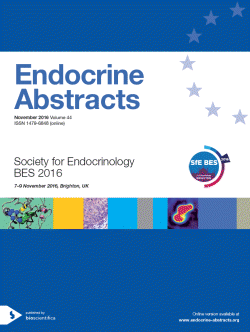
Society for Endocrinology BES 2016
Brighton,
UK
07 Nov 2016 - 09 Nov 2016

Oral Communications
Thyroid and Neoplasia
ea0044oc3.1 | Thyroid and Neoplasia | SFEBES2016
Frequent Occurrence of DUOX2 and DUOXA2 Mutations in Cases with Borderline Bloodspot Screening TSH who Develop ‘True’ Congenital Hypothyroidism
Peters Catherine , Nicholas Adeline K , Lyons Greta , Langham Shirley , Serra Eva , Schoenmakers Erik , Muzza Marina , Fugazzola Laura , Schoenmakers Nadia
ea0044oc3.2 | Thyroid and Neoplasia | SFEBES2016
Pharmacological enhancement of radioiodine uptake through Src kinase inhibition
Poole Vikki , Fletcher Alice , Modasia Bhavika , Sharma Neil , Thompson Rebecca , Nieto Hannah , Imruetaicharoenchoke Waraporn , Read Martin , Boelaert Kristien , McCabe Christopher , Smith Vicki
ea0044oc3.3 | Thyroid and Neoplasia | SFEBES2016
Post-Radioiodine Graves’ Management: The Pragma-Study
Perros Petros , Dayan Colin , Vaidya Bijay , Williams Graham , Lazarus John H , Hickey Janis , Willis Debbie , Archer Natasha , Franklyn Jayne , Basu Ansu
ea0044oc3.4 | Thyroid and Neoplasia | SFEBES2016
Identification of novel sodium iodide symporter (NIS) interactors which modulate iodide uptake
Fletcher Alice , Poole Vikki , Modasia Bhavika , Imruetaicharoenchoke Waraporn , Thompson Rebecca , Sharma Neil , Nieto Hannah , Read Martin , Turnell Andrew , Boelaert Kristien , Smith Vicki , McCabe Christopher
ea0044oc3.5 | Thyroid and Neoplasia | SFEBES2016
Identification of murine neuroendocrine tumour (NET) cell binding peptides identified through phage display
Stevenson Mark , Javid Mahsa , Lines Kate , Thakker Rajesh
ea0044oc3.6 | Thyroid and Neoplasia | SFEBES2016
Oestrogens Stimulate Proliferation in Colorectal Cancer via GPER and the Hippo signalling pathway
Arvaniti Anastasia , Gilligan Lorna , Rahman Habibur , Gondal Ali , Foster Paul



